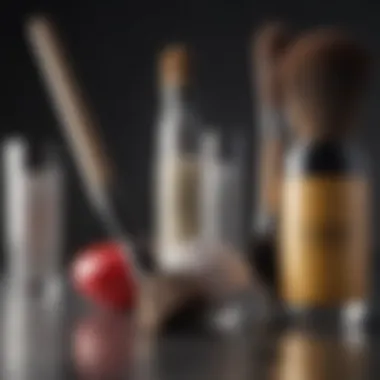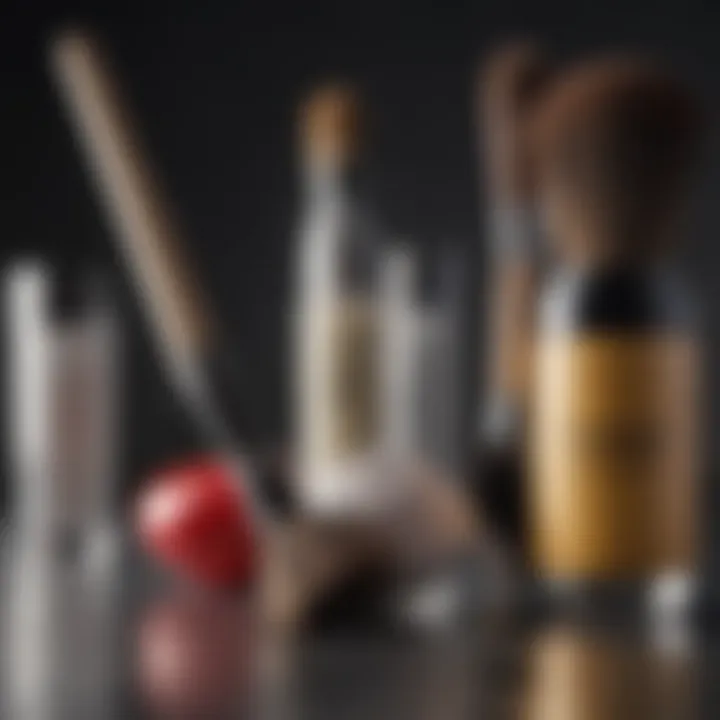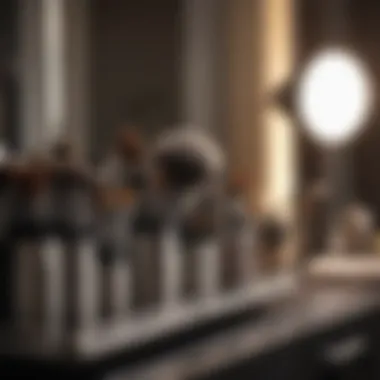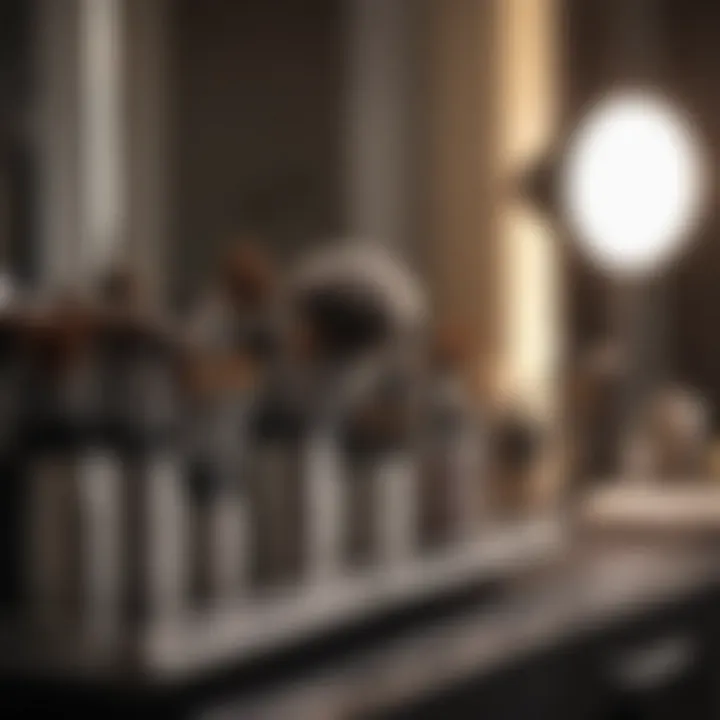A Comprehensive Guide to Cleaning Makeup Brushes at Home


Intro
Keeping makeup brushes in tip-top shape is not just about aesthetics; it's about maintaining skin health and ensuring the tools perform at their best. A dirty brush can become a breeding ground for bacteria, which can lead to breakouts and skin irritations. Furthermore, clogged bristles don't apply makeup as smoothly as clean ones, which can ruin your carefully crafted look.
In this guide, we will explore every facet of cleaning makeup brushes right in the comfort of your home. You'll learn why it's vital to keep your brushes clean, the materials you should consider when choosing your brush cleaning tools, and how to execute effective and safe cleaning methods. Additionally, we’ll delve into some commonly overlooked tips that can enhance the longevity of your brushes, so they serve you well for years to come.
This isn't merely a chore; it’s an essential part of your beauty regimen that will ultimately elevate your makeup application to a new level. So, buckle up, as we dive deep into a topic that often gets swept under the rug but is crucial for anyone serious about their beauty routine.
Understanding the Importance of Cleaning Makeup Brushes
Cleaning your makeup brushes is not just a good idea; it's a necessity. Many people underestimate the impact that dirty brushes can have on skin health, the lifespan of the brushes, and overall makeup application. Let’s delve into why maintaining brush hygiene should be at the forefront of every beauty regimen.
Impact on Skin Health
The skin is a sensitive organ, and exposing it to bacteria lurking on unclean brushes can lead to issues like breakouts and irritation. When brushes aren’t washed regularly, they accumulate oil, dirt, and dead skin cells. This cocktail of grime can easily find its way onto your face, leading to clogged pores and pesky pimples. For instance, if you used the same brush for applying foundation without cleaning it, you're essentially layering makeup over a breeding ground for bacteria. It’s not just about aesthetics; it's about protecting your skin from unnecessary challenges that could have been avoided.
Prolonging the Life of Brushes
Makeup brushes are an investment, and every beauty maven knows that quality tools can come with a hefty price tag. By regularly cleaning your brushes, you not only keep them in good shape but also extend their lifespan. Brushes with caked-on product can become stiff and lose their original form, which can make them less effective in application. The result is a disappointing makeup look that can throw a wrench in your daily routine. Maintaining cleanliness means your brushes will remain soft and pliable, doing their job beautifully—think of it like giving your brushes a revitalizing spa day.
Achieving Better Makeup Application
Let's face it: the way makeup applies often hinges on the tools used. A clean brush ensures that your makeup goes on smoothly and evenly. If you've ever tried to blend eyeshadow with a dirty brush, you’ll understand the frustration—it can lead to streaks and uneven color. What’s worse, using a dirty brush can cause your favorite products to mix with remnants of old product, not providing the fresh pop you aim for. In essence, clean brushes lead to better application and a flawless finish. So when you skip cleaning, you may be setting yourself up for a makeup misfire.
"Regularly cleaning your brushes is not merely a maintenance task; it's a vital aspect of any beauty regimen that impacts your skin's health, brush longevity, and makeup application quality."
In summary, cleaning your makeup brushes is crucial for skin health, prolonging the life of your tools, and achieving that enviable seamless application. It’s clear that a little effort in maintaining brush hygiene leads to a world of difference in your overall beauty experience.
Types of Makeup Brushes
Understanding the various types of makeup brushes is essential for any makeup enthusiast. It not only helps in selecting the right tools for specific applications but also plays a significant role in how to care for these brushes effectively. Different bristles, shapes, and even materials can dramatically influence not just the application of makeup, but also the maintenance practices you'll need to adopt.
Natural Hair Brushes
Natural hair brushes are crafted from animal hair, like squirrel, goat, or pony. They have a unique ability to pick up and blend products seamlessly, making them a favorite among makeup artists. Their soft fibers allow for a smooth application of powders and pigments. There’s a noticeable difference when using these brushes compared to their synthetic counterparts.
However, it’s crucial to keep in mind that these brushes require a specific cleaning method. The porous nature of natural hair absorbs oils and products, meaning they can hold onto bacteria and dirt if not cleansed properly. This cleanliness is vital for maintaining skin health. Regular cleaning ensures that your brushes deliver the same high-quality application every time.
Synthetic Brushes
Synthetic brushes, made from materials like nylon or polyester, are highly versatile and can be found in various shapes and sizes. They're particularly advantageous for liquid or cream products because their dense bristles won't absorb much product, leading to efficient application without wastage.
One of the standout benefits of synthetic brushes is their durability. They're generally easier to clean and maintain compared to natural hair brushes. A simple soap and water solution is often sufficient, and they dry quickly too. For many, reducing drying time is a game-changer. Given their structure, synthetic brushes can also be less prone to harboring bacteria, though regular cleaning is still imperative to ensure they remain in prime condition.
Specialty Brushes
Specialty brushes cater to specific needs, ranging from precise detailing to larger coverage areas. Think about fan brushes, which excel at sweeping on highlighters or softening edges, or angled brushes that help in achieving that perfect eyeliner flick. Each of these brushes serves a unique purpose in the makeup world.
With specialty brushes, understanding their use case is just as important as knowing how to clean them. For instance, a stippling brush for foundation application might require a different cleaning technique than a brush used for blending eyeshadows. Knowing how to properly care for these tools ensures their longevity and helps you avoid any mishaps, like loosing bristles or damaging the shape.
Gathering Necessary Supplies
When embarking on the journey of cleaning your makeup brushes at home, the first step requires consideration of the supplies you’ll need. Gathering necessary supplies is not just about convenience; it sets the stage for effective cleansing. Having the right tools at your disposal plays a vital role in ensuring the brushes are cleaned thoroughly and efficiently, ultimately uplifting your overall makeup application.
Choosing the Right Cleanser
Selecting an appropriate cleanser is crucial, as the type you choose directly impacts the cleanliness and longevity of your brushes. Generally, there are two options:
- Commercial Brush Cleaners: These products are formulated specifically for makeup brushes. They often contain ingredients that can effectively dissolve makeup residues while being gentle on the bristles. What’s more, they usually have a pleasant scent, turning your cleaning routine into a more enjoyable experience.
- DIY Cleaners: If you're looking for an eco-friendly or budget-friendly alternative, a mixture of gentle soap (like baby shampoo or dish soap) and olive oil can work wonders. This blend not only cleans the brushes but also helps in keeping their bristles soft.
Consider your skin type, the products you use, and how often you clean your brushes when picking a cleaner. For instance, if your skin is sensitive, a fragrance-free cleanser would be a wise choice.
Optional: Additional Cleaning Tools
Cleaning Mats
Cleaning mats have emerged as a favorite among makeup enthusiasts. These textured mats provide a surface that helps to agitate and lift dirt and oils from the brush bristles effectively. One of the most significant advantages of using a cleaning mat is the stability it adds during the cleaning process. You can simply place the mat in your sink, reducing the chance of dropping brushes or spilling cleanser.
"Using a cleaning mat is like having a trained assistant in your beauty routine - it tackles the dirt while you focus on the details!"
Though they are widely regarded as beneficial, some may find cleaning mats cumbersome to store due to their size. Still, their efficiency often outweighs these considerations.
Microfiber Cloths
Microfiber cloths are another handy tool in this cleaning endeavor. They are highly absorbent and can quickly dry brushes after rinsing, minimizing the risk of water seeping into the ferrule, which could damage them. What sets microfiber cloths apart is their abrasiveness - they can gently scrub away residue without damaging the bristles.
However, it’s essential to note that microfiber cloths require proper washing after use, to maintain hygiene. While they’re a very popular option, they might not be as cost-effective in the long run compared to other cleaning tools.
Basic Cleaning Method


Cleaning makeup brushes is not just a chore; it’s an essential practice that enhances both the tools and your beauty routine. By adopting a basic cleaning method, you can make sure your brushes are devoid of dirt, oil, and makeup residue. This article articulates the steps in a systematic way, helping simplify what may seem like an overwhelming task. Regular cleaning goes beyond hygiene; it is also a means to ensure your brushes perform at their best, giving you impeccable application and flawless finishes.
Step-by-Step Process
Wet Brushes
The first step, known as wetting the brushes, is where the journey to clean brushes begins. Think of it as giving your brushes a refreshing shower. When you wet your brushes under lukewarm water, it not only helps loosen stubborn makeup particles but also readies the bristles for the forthcoming cleanser.
One key characteristic of wet brushes is that they should never be submerged in water. Keeping the ferrule dry is crucial, as moisture can seep in, damaging the glue that binds the bristles. Wetting allows the cleanser to work more effectively in the next steps. While it may seem like a mundane task, this step is absolutely vital, providing an optimal base for proper cleaning.
Add Cleanser
After you’ve thoroughly wet your brushes, the next step is to add the cleanser. Selecting the right cleanser is paramount; a gentle one is preferred as it won’t compromise the integrity of the bristles. Using an appropriate makeup brush cleanser or even natural alternatives can be effective.
The key characteristic here lies in the action of the cleanser breaking down the oils and pigments that stick to your brushes. This means adding a few drops of cleanser directly onto the bristles while gently swiping in a circular motion. The unique feature of this process is that it not only cleanses but also conditions the bristles, extending their lifespan. However, some may opt for harsher soaps, thinking they will provide a deeper clean, but these can wear down the bristles over time.
Rinse Thoroughly
The final step in this basic cleaning method is rinsing thoroughly. This step is critical to ensure the bristles are free from both cleanser and residual makeup. Rinsing helps in achieving the aim of cleanliness and prepares the brushes for the drying phase.
One important aspect to remember is to continue rinsing until the water runs clear, indicating that all the product has been removed. Failing to rinse properly can lead to build-up and irritation on the skin in the long run. The thorough rinsing technique makes this phase not only significant in the cleaning process but also beneficial for maintaining healthy brushes.
Drying Techniques
After you’ve gone through the cleaning process, drying your brushes correctly is crucial, too! Often overlooked, improper drying can lead to mildew or bristle damage. The best way to dry brushes is on a flat surface, allowing air to circulate without getting to the bristles or wood. Hanging them upside down is another option, but make sure to use a holder that can catch the water without weighing down the bristles.
Avoid drying them upright in a cup, as this allows water to seep into the ferrule, possibly causing long-term damage. The drying phase should never be rushed; allowing them to dry naturally ensures they remain in good condition for your next makeup application.
"A clean brush is the artist's best friend; it's essential for a flawless finish."
Taking the time to follow these basic cleaning methods will undoubtedly enhance your makeup experience. Regular maintenance provides not only healthier skin but also prolongs the life of your brushes, ensuring that they stay effective and perform at their best.
Deep Cleaning Your Brushes
Keeping your makeup brushes clean is about more than just aesthetics; it’s about the health of your skin and the effectiveness of your makeup application. Deep cleaning your brushes regularly helps remove built-up grime, oils, and bacteria that can impair performance or even lead to breakouts. It's crucial to establish a deep cleaning routine to maintain both the tools and the overall cleanliness of your makeup kit.
When to Deep Clean
Knowing when to deep clean can make all the difference in maintaining your brushes. It is generally suggested that you perform a deep clean once a month. However, consider these factors:
- Usage Frequency: If you use your brushes daily, especially for liquid products like foundation or concealer, you might want to up that frequency.
- Sensitivity of Your Skin: If your skin tends to break out easily, more frequent deep cleaning can help mitigate that risk.
- Type of Products Used: Products with more pigments or oils will require more diligent cleaning, so keep an eye on how your brushes perform after such applications.
The key is to listen to your tools; if you notice them not performing as well, it’s time to give them a good clean.
Deep Cleaning Techniques
Deep cleaning can be effectively achieved through different methods. Let's explore two popular techniques: the soaking method and the use of ultrasonic cleaners.
Soaking Method
The soaking method is a straightforward technique that can be quite beneficial, especially for brushes that have accumulated a lot of residue. By submerging the brushes in a cleaning solution, you allow the fibers to absorb the cleanser and loosen the buildup. This method is popular due to its simplicity and ease of execution.
- Key characteristic: The soaking method requires a bit of patience, as you’ll usually need to soak the brushes for several minutes.
- Unique feature: It effectively dislodges trapped dirt and makeup deeper within the bristles, something that simple rinsing may not achieve.
- Advantages: This technique can accommodate multiple brushes at once, making it time-efficient.
- Disadvantages: If not monitored closely, brushes may absorb too much water and can lead to damage over time.
Overall, the soaking method stands out as a beneficial choice for an intensive clean but does require a watchful eye to avoid mishaps.
Ultrasonic Cleaners
Ultrasonic cleaners are a modern solution gaining traction in the beauty community. Using sound waves to create vibrations, they agitate the cleaning solution, effectively washing brushes in a more thorough manner.
- Key characteristic: These devices provide a hands-free cleaning experience, which lets you multitask while your brushes are being cleaned.
- Unique feature: The sound waves penetrate into the bristles to eliminate stubborn grime that could otherwise be missed.
- Advantages: They can clean multiple brushes simultaneously with superior results, making them highly efficient.
- Disadvantages: The initial investment can be a bit pricier than traditional methods, potentially limiting access for some users.
Employing an ultrasonic cleaner can elevate your brush maintenance routine, giving you immaculate tools ready for flawless makeup application.
Ultimately, whether you choose the soaking method or an ultrasonic cleaner, the goal remains the same: keep your brushes in tip-top shape for the healthiest makeup experience possible.
Cleaning Specific Brush Types
When it comes to keeping your makeup brushes in tip-top shape, understanding how to clean specific brush types is downright essential. Different brushes are crafted for varied purposes, and each one requires a tailored approach to cleaning. Not only can this enhance their performance and longevity, but it can also ensure a smoother and more even application of makeup. Trust me, you don’t want to be using a dirty brush that can harbor bacteria and leftover pigments!
Foundation Brushes
Foundation brushes are vital for achieving that flawless complexion. Whether you fancy a liquid, cream, or powder foundation, these brushes can absolutely transform how your base looks. But guess what? They can also be some of the germiest tools in your kit due to the thick, oily consistency found in foundations.
To keep your foundation brushes clean and at their best:
- Frequency: Clean them after each use, if possible, especially if you tend to use various foundation shades.
- Method: Use a gentle soap or a dedicated brush cleaner. You really don’t want to irritate your skin with any harsh chemicals. Rinse thoroughly to ensure no product remains—leftover foundation can cause breakouts or texture issues.
Make sure you reshape the bristles after cleaning. This helps maintain their structure and prevents any awkward splaying!


Eyeshadow Brushes
Eyeshadow brushes might seem less critical, but their cleaning is quite the game-changer. A well-maintained eyeshadow brush offers better color payoff and blends effortlessly, which makes all the difference on your eyelids. Just picture using a brush that still has residues of yesterday’s bold blue on it while trying to apply a soft brown. Not ideal!
For these brushes:
- Daily Care: If you're using different shades, try a quick wipe-down with a microfiber cloth or a brush cleaner spray. It's quick and does the trick.
- In-Depth Cleaning: Once a week, give them a thorough wash. Use lukewarm water and a gentle cleanser. Avoid soaking them in water completely as this can loosen the glue and warp the shape.
It’s also good practice to keep an eye on your brushes. If you notice bristle shedding or misshaped brushes, it might be time to consider replacements.
Blush and Contour Brushes
Now, onto blush and contour brushes! These brush types are crucial for chiseling out those cheekbones and adding that flush of color. They can often trap powders and pigments, which can later affect how your makeup looks on application.
To maintain them:
- Cleaning Routine: Like foundation brushes, these should ideally be cleaned every couple of uses, especially if you alternate between cream and powder products.
- Technique: Swirl the brush in a soapy solution, then gently press it against a clean towel to remove excess water. Avoid getting the base of the bristles wet as moisture can seep into the handle and damage the glue.
Remember, having a fresh and clean brush not only improves makeup application but also how makeup behaves on the skin. With regular cleaning, you’re setting yourself up for a consistent look—no surprises and no telltale signs of yesterday’s glam.
"A clean brush is an artist’s best buddy!"
Overall, understanding how to clean specific brush types not only prolongs their lifespan but also protects your skin and enhances your makeup game. Don’t skimp on this part of your beauty routine. It's genuinely worth it!
Common Mistakes to Avoid
Keeping makeup brushes clean is not simply a matter of ritual; it plays a significant role in ensuring both skin health and the performance of your brushes. Nevertheless, many enthusiasts or novices make common mistakes that can ultimately undermine this essential task. Here are some key areas to watch out for, along with explanations on why avoiding these pitfalls is crucial for effective brush cleaning.
Using Too Much Water
While water is the essence that binds the cleaning process together, an excess of it can cause more damage than good. Over-saturating your brushes will not only dilute your cleansers but might also lead to unwanted consequences. Natural hair brushes are particularly susceptible to such mishaps. The excess moisture can loosen the glue that holds the bristles in place, resulting in a shedding situation that we all dread.
Here are a few points to keep in mind regarding water usage when cleaning brushes:
- Gentle Rinsing: Ensure you're rinsing brushes under lukewarm water, allowing the bristles to be cleaned without being blasted with too much force.
- Positioning: Always hold the brush with the bristles facing downward. This helps prevent water from seeping into the ferrule (the metal part) and damaging the glue inside.
- Controlled Quantity: A little goes a long way. Aim for just enough water to moisten the bristles without soaking them.
Improper Drying Methods
Once the cleaning is done, it might be tempting to just throw the brushes on a towel or let them air dry however they land. However, improper drying can ruin the shape of your brushes and lead to more serious issues like mildew. To safeguard your investments, a strict drying protocol is crucial.
Consider these effective drying techniques:
- Reshape the Bristles: After washing, reshape the bristles while they're still wet to ensure they maintain their form.
- Flat Drying: Avoid standing brushes upright unless you're certain they are designed for it. Placing them flat on a clean, dry towel will prevent water from running into the ferrule.
- Adequate Space: Lay brushes with enough room in between so they don’t clump together. Choosing a well-ventilated area for drying is ideal, as it allows for thorough drying without trapped moisture.
"Cleaning your brushes should feel less like a chore and more like an investment in your skin and your tools."
By avoiding these common mistakes, you elevate your brush cleaning to a level that promotes longevity and effectiveness. The journey to flawless makeup application starts with understanding the very tools that create those masterpiece looks.
Frequency of Cleaning
Cleaning makeup brushes regularly isn't just a good idea; it’s a necessity. When you think about it, brushes are often the unsung heroes of our beauty routine. They pick up everything from foundation to glitter eyeshadow and then, without a second thought, we toss them back into our makeup bag. But the build-up of product, dirt, and bacteria can lead to skin breakouts and decreased brush performance.
To keep your tools in tip-top shape, establishing a consistent cleaning routine is paramount. Regular cleaning minimizes the risk of skin irritations and allergies. Imagine this: you’ve just applied a lovely foundation, but there’s that pesky clump of old makeup stuck at the base of your brush. This could not only mar that smooth finish but also cause skin irritation. An ounce of prevention—cleaning—can save you headaches down the line.
Daily vs. Weekly Cleaning Routines
When it comes to the actual fun of cleaning your brushes, it often begs the question: How often should you do it? Here’s the lowdown:
- Daily Cleaning: For brushes that touch your skin daily, like foundation or concealer brushes, a quick clean after each use can be quite beneficial. Use a gentle spray cleanser or even a homemade mixture of water and rubbing alcohol. Just a few swipes on a clean towel can help remove any makeup left on the bristles. This will become your daily ritual, taking mere seconds but yielding terrific results.
- Weekly Cleaning: Reserve a more thorough cleaning for once a week. It’s the perfect time to give your brushes a real scrub, breaking down that make-up buildup. For this, employ a mild soap or dedicated brush cleanser. Soak the bristles and lather them up, then rinse until the water runs clear. This weekly spa day for your brushes will ensure that they remain functional and effective over time.
Factors Influencing Cleaning Frequency
There are quite a few elements that could play into how often you should clean your brushes. Consider these factors:
- Skin Type: If you have oily or acne-prone skin, you might want to take the cleaning a step further and wash brushes used on your face more frequently. The excess oil can seep into bristles and then onto your skin.
- Usage Level: More use means more dirt. If you’re layering your makeup every day or using certain brushes more frequently than others, they need to be washed more often.
- Product Type: Some products, especially cream-based ones, can gunk up brushes quicker than powders. Keep an eye on how your products affect your tools.
Environmental Considerations
As the beauty industry evolves, so does the awareness surrounding environmental impacts. Cleaning makeup brushes isn’t just about personal hygiene; it intersects with broader ecological concerns, like waste and pollution. Recognizing these factors can empower consumers to make better choices while maintaining their beauty tools. By adopting eco-friendly practices, you contribute positively to the planet's health while enhancing your makeup experience.
Eco-Friendly Cleaning Products
The beauty aisles are lined with various cleaning products, many of which contain harsh chemicals that can leach into waterways and harm aquatic life. Opting for eco-friendly cleaning products is vital not just for your skin, but for the environment too. Natural and biodegradable cleansers help to minimize this impact. Additionally, many brands now offer plant-based formulas that deliver effective cleaning without the toxic baggage. Look for products that highlight their sustainable credentials, such as cruelty-free testing and recyclable packaging.
Using ingredients like coconut oil, vinegar, or essential oils can be an excellent alternative. For instance, mixing a little warm water with a splash of olive or castor oil creates a gentle yet effective brush cleaner. Not only do these ingredients help remove grime, but they also reduce reliance on synthetic compounds that just end up polluting.
Reducing Waste in Brush Care
Every component of your beauty routine can influence waste production. From single-use items to disposable sponges, many options lead to mountains of waste. On the flip side, maintaining your brushes can significantly reduce waste, keeping your beauty routine sustainable. Regular cleaning extends the life of your brushes, meaning fewer replacements and less landfill contribution.


One practice to consider is using reusable cleaning tools, such as silicone mats or scrubbing pads. They not only enhance your cleaning efficiency but are also less wasteful compared to disposable tissues or wipes.
Incorporating simple habits like cleaning brushes more frequently can alter the lifecycle of your tools, ultimately leading to less waste. Consider these actions:
- Invest in Quality Brushes: Good brushes can endure years of cleaning when properly maintained.
- Create a Cleaning Schedule: Planning cleaning sessions can help you stay on track and cut down on the tendency to procrastinate, which may lead to needing to replace brushes sooner due to neglect.
"The best way to show love for your makeup tools is not just to use them, but also to care for them in harmony with our planet."
Ultimately, making conscious decisions about the products you use and the care methods you choose can lead to a healthier lifestyle and a cleaner environment. Engaging with these practices further enriches the experience of both beauty and responsibility.
Storing Your Brushes
Storing your makeup brushes correctly isn't just a matter of aesthetics; it plays a critical role in ensuring their longevity and performance, as well as maintaining hygiene. Brushes that are left strewn about willy-nilly might not only become damaged but can also accumulate dust and bacteria, which we obviously want to avoid. A tidy storage solution can also help you easily find the brushes you need when applying your makeup, saving you time and hassle each morning.
Optimal Storage Solutions
When considering how to store your brushes, think of it as creating a little sanctuary for them. A good storage solution not only protects the bristles but also ensures they retain their shape. Here are some options:
- Brush Holder or Cup: Simple yet effective. A sturdy holder can prevent brushes from bending or crushing each other. Look for one that is tall enough to keep the bristles safe.
- Zippered Pouches: Ideal for travel or if you have limited space at home. These help to keep everything clean while allowing you to transport your brushes easily.
- Magnetic strips: Although unconventional, a clean magnetic strip mounted on a wall can be handy. Brushes with metal ferrules catch magnetically, keeping them visible and easy to access.
- Drawer organizers: If you have a makeup drawer, adding separators will help your brushes stand upright and organized, away from other tools that may damage them.
Avoiding Damage During Storage
Proper storage goes hand in hand with avoiding damage. Here are some considerations to keep in mind:
- Keep Brushes Upright: Always store brushes with the bristles facing up. This helps to maintain their shape and prevents any wear and tear that can occur if they're laying flat.
- Limit Sun Exposure: Too much heat and sunlight can degrade brush materials, particularly the glue that holds the bristles together. Store your brushes in a cool, dark place.
- Avoid Crowding: Don’t stack brushes on top of each other. Crowding can lead to a loss of shape, not to mention they can pick up dirt from other products.
- Regular Dusting: If your brushes are placed in a holder, it’s good practice to regularly dust the storage area to keep bacteria at bay.
"Store your brushes like you would a fine wine; with care and protection, so they last longer and remain effective."
Proper storage can make a world of difference in how your brushes perform and how long they last. Whether you choose a dedicated brush holder or clever DIY hacks, understanding the best practices for storing your tools is essential for every makeup enthusiast.
Troubleshooting Brush Cleaning Issues
Cleaning makeup brushes can sometimes resemble a game of whack-a-mole. Just when you feel you’ve got it sorted, another issue can pop up—be it stubborn residue or unexpected brush damage. Understanding how to troubleshoot these problems is essential for maintaining the integrity of your brushes and, ultimately, your skincare and makeup routine. Without addressing these issues head-on, you run the risk of not only needing to replace tools sooner than expected but also of jeopardizing skin health due to unhygienic brushes.
Dealing with Stubborn Residue
Stubborn residue on your brushes often comes from a mix of dried makeup, oils, and product build-up. This residue can be a troublesome nuisance and can compromise the effectiveness of your brushes. So, how do you tackle it?
- Warm Water Soak: Sometimes, all it takes is a little warmth. Soak the bristles in warm water for a few minutes. This loosens up the build-up and makes it easier to clean.
- Gentle Scrubbing: After soaking, apply a gentle cleanser. A few drops of baby shampoo or specialized brush cleanser can work wonders. Use your fingers to gently massage the bristles, focusing particularly on areas with visible residue. Be careful not to pull too hard; you don’t want to lose hair from the brush.
- Rinse Thoroughly: Thorough rinsing is crucial. Any lingering cleanser can lead to additional build-up in the future. Ensure that all soap is gone before laying the brushes flat to dry.
- Repeat if Necessary: Some brushes, especially those used for thicker formulas like cream foundations, may require a second cleaning session. Don't shy away from giving them extra care if they still feel gritty.
"A clean brush is like a clean slate; it allows your makeup to perform its best without interference from leftover products."
Brush Damage: Causes and Solutions
Brushes can be delicate, and improper handling can lead to various forms of damage, from frayed bristles to loss of shape. Identifying the causes of such damage, and knowing how to prevent and resolve it, is fundamental for any beauty aficionado.
Common Causes of Brush Damage
- Excessive Force While Cleaning: If you scrub with too much vigor, you risk damaging the bristles. Always aim for a gentle touch.
- Using Harsh Chemicals: Some cleaners can degrade the bristles, particularly if they are synthetic. Opt for a gentle, pH-balanced soap instead.
- Incorrect Drying Techniques: Placing brushes upright in a container to dry can lead to water seeping into the ferrule, which can loosen the bristles.
Solutions to Minimize Brush Damage
- Choose the Right Cleanser: As mentioned, stick with mild cleansers. Your brushes will thank you over the long haul.
- Mindful Drying: Lay brushes flat on a clean towel to dry, ensuring that the bristles retain their shape and structure.
- Regular Maintenance: Keep up with your cleaning schedule. Regular cleaning can actually prevent stubborn build-up and lessen the chance of damage over time.
Understanding these troubleshooting methods equips you with the knowledge to uphold the necessary standards for your brush care, allowing for a smoother, more enjoyable makeup application experience. Proper care ensures that your brushes last longer, perform better, and help maintain clear skin.
Closure and Summary of Best Practices
In wrapping up this guide on cleaning makeup brushes, it’s clear that maintaining your tools goes beyond just aesthetics. It's about taking care of your skin and enhancing your overall beauty routine. The act of cleaning brushes, though sometimes seen as a chore, holds immense value for anyone who uses makeup regularly. Better hygiene leads to better skin health, as dirty brushes can harbor bacteria and lead to breakouts. Additionally, properly cared-for brushes last longer, saving more money in the long run.
Understanding how to clean various types of brushes is crucial. Each type has its own care requirements and cleaning methods. For instance, natural hair brushes benefit from gentler cleansers compared to synthetic ones. Implementing a consistent cleaning schedule can avoid the stress of dealing with stubborn residue that builds up over time.
"Neglecting brush maintenance is akin to overlooking your skincare routine; it's only a matter of time before you face consequences."
It’s also vital to note that the methods and products you choose can influence the longevity of the brushes. Opt for cleansers designed specifically for makeup tools, ideally avoiding harsh chemicals that can deteriorate the bristles. Whether using a soaking method or ultrasonic cleaner, no cleaning method is truly one-size-fits-all.
In summary, the best practices for brushing cleaning include:
- Regular cleansing: Establish a routine, be it daily or weekly.
- Choose cleansers wisely: Natural and gentle cleansers take the cake when it comes to maintaining the brush's integrity.
- Dry properly: Letting them air dry in a suitable position prevents undue damage.
Ultimately, committing to clean brushes plays a significant role in your makeup experience. It leads to better applications, richer pigments, and healthier skin, all while extending the life of your tools.
Recap of Key Points
In revisiting our discussion, several key items stand out:
- Skin Health Impact: Clean brushes are crucial for preventing skin issues.
- Brush Longevity: Proper care extends the life of your brushes, making maintenance cost-effective.
- Makeup Results: Clean tools directly contribute to a flawless application.
Each of these points highlights the simplicity yet complexity of brush maintenance. The task is not monumental but attainable with mindful practice.
Encouragement for Regular Maintenance
Carving out time for regular brush maintenance is definitely not just a simplistic notion; it’s a necessity for anyone who engages with cosmetics. It often takes little more than a few minutes a week to transform your makeup routine completely. Not only does this promote better hygiene and performance, but it also creates a ritual of care for your beauty tools.
Incorporate this maintenance into your overall beauty regimen, perhaps after your skincare routine or during a refresher break in your day. Soon enough, it will become second nature. Consider keeping a visual reminder or even an alert on your smartphone to check your brushes weekly. Also, discussing techniques with friends can foster accountability and perhaps spark conversations about best practices.
By maintaining this diligence, you ensure that your brushes serve you well, delivering optimal makeup results without compromising your skin's health. As the saying goes, "a stitch in time saves nine;" so does a little brush care save much makeup hassle later on.



